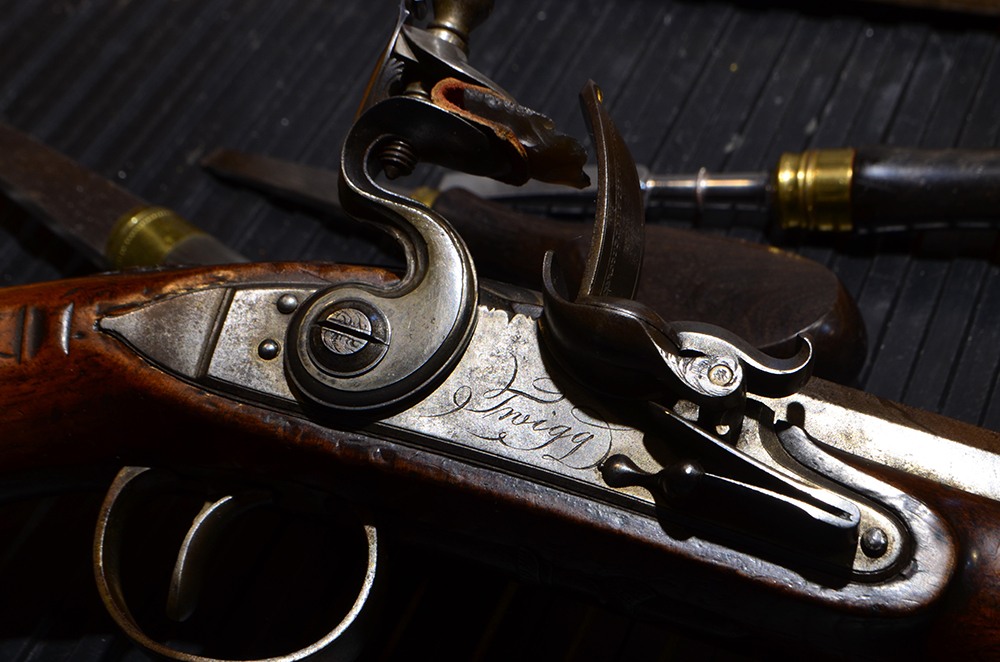
by Terry Wieland
The name John Fox Twigg is not as well known as it might be. I am embarrassed to say that, until recently, it was a name I’d read, heard, and come across, but never paid much attention. Then, at the Rock Island auction in early June, I landed a Twigg duelling pistol — a .52-caliber flintlock from around 1770.
Naturally, this led to a search of all my books, and then to a search of any available books to be had on-line (with all the travail that entails) in an effort to find out as much as possible about John Twigg, his guns, and where he fits into the vast panoply of English gunmaking.
In a nutshell, Twigg was one of the most prominent gunmakers in London around the time of the American war of independence. From our vantage point, two centuries on, his major claim to fame would be that John Manton was his apprentice, rose to be Twigg’s foreman before going out on his own, and was heavily influenced by Twigg’s taste and style.
In my column in Gray’s earlier this year, I explored the relationship that existed between George Bryan “Beau” Brummell, unquestionably history’s most influential man of style, and Joseph Manton, John’s younger brother. The later London style in guns, that of “quiet elegance, the best materials, superb workmanship, devoid of spurious ornamentation” also describes men’s fashions as decreed by Brummell, and followed to this day by well-dressed men.

That was an age of great men in many realms, not the least of whom, and some would argue the greatest of whom, was Arthur Wellesley, the Duke of Wellington. It’s worth noting that paintings of the Duke almost invariably depict him, when not in uniform, dressed as Brummell would have wished: a superbly cut coat of midnight blue, snowy linen, no ostentation whatever, yet an air of authority.
The Manton brothers are generally credited with originating the London style in guns, and also with turning the fowling piece from a crude workman’s tool into an art form. Before the fowling piece, however, the most notable “gentleman’s gun” was the duelling pistol, and one of the great names in duelling pistols was John Fox Twigg.
In their two-volume history, The Mantons: Gunmakers, Keith Neal and David Back credit Twigg with originating several practices and features which influenced, first, John Manton, and through him, his brother Joseph, then James Purdey, Thomas Boss, Charles Lancaster, and finally the entire London gun trade.
The most influential was Twigg’s eschewing of such showy gewgaws as silver pistol grip caps in favor of steel — meticulously fitted, finely polished, and tastefully engraved. For several centuries, guns made for kings and emperors were noted for elaborate gold and silver fittings worthy of Benvenuto Cellini. Twigg believed the wood and steel of a gun’s mechanical parts could be, and should be, sculpted in such a way that they would stand on their own as works of the finest artisanship.
This extended to the gun’s overall grace and form, with its lines and profile as essential to its good looks as any engraving or inlay of precious metals. If it could be summed up in two words, those would be “understated elegance.”
In 1781, John Manton left Twigg’s employ to set up on his own, and took the Prince of Wales with him as a client. The Prince later became Beau Brummell’s close friend (the Beau was best man at the Prince’s wedding in 1795). In 1816, Brummell fled London and the ignominy of bankruptcy, and his possessions were sold at auction. Among them were “three capital fowling pieces by Manton.” John or Joseph? Probably the former, as he signed his work simply “Manton” while his brother signed his “Jos. Manton.” But, at this late date, who knows?
John Twigg was only 60 years old when he died in 1792. To all intents, his business died with him, but his influence lived on. When John Manton made up his very first trade cards — this was before case labels became common — they read “from Twigg,” just as, later, James Purdey’s would read “from Manton,” and Henry Atkin’s would read “from Purdey.”
If one were to fashion a family tree tracing the evolution of the London style in gunmaking, Twigg would be — you’ll excuse the expression — a prominent root.
______________________________________________________________________________
The capacity of Gray’s shooting editor to become fascinated by the most arcane corners of gunmaking appears to be limitless. Now the question is, who influenced John Twigg?
